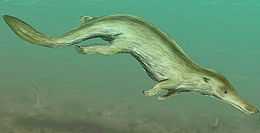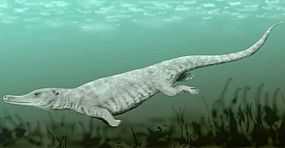Remingtonocetidae
| Remingtonocetidae Temporal range: Early-Middle Eocene, 49–43Ma | |
|---|---|
 | |
| Kutchicetus | |
 | |
| Remingtonocetus | |
| Scientific classification | |
| Kingdom: | Animalia |
| Phylum: | Chordata |
| Class: | Mammalia |
| Order: | Cetacea |
| Suborder: | Archaeoceti |
| Family: | Remingtonocetidae Kumar & Sahni 1986 |
| Genera | |
|
See text | |
Remingtonocetidae is a diverse family of early aquatic mammals of the order Cetacea, endemic to the coastline of the ancient Tethys Ocean during the Eocene (present-day Pakistan and India).[1] The name of the family was derived from the genus Remingtonocetus which was named after paleocetologist Remington Kellogg.[1]
Description
Remingtonocetids have long and narrow skulls with the external nare openings located on the front of the skull. Their frontal shields are narrow and their orbits small. Their mouth has a convex palate and an incompletely fused mandibular symphysis. The dental formula is 3.1.4.33.1.4.3. The anterior teeth are flattened mediolaterally, making them appear shark-like.[2]
In the postcranial skeleton, the cervical vertebrae are relatively long and the sacrum is composed of four vertebrae of which at least three are fused. The acetabular notch is narrow or closed and on the femoral head the fovea is absent.[2]

Cranial fossils are common but dental remains are rare. The postcrania morphology is based entirely on a single specimen of Kutchicetus which was small and had a long and muscular back and tail. Perhaps Remintonocetids swam like the South American giant otter which swims with its long flat tail.[3]
With long and low bodies, relatively short limbs, their elongated rostrum, Remingtonocetids looked like mammalian crocodiles, more so than Ambulocetus. They could both walk on land and swim in the water and most likely lived in a near-shore habitat. At least one genus, Dalanistes, had a marine diet.[1]
Remingtonocetids are often found in association with catfish and crocodilians, as well as protocetid whales and sirenians. They were probably independent of freshwater.[3]
Taxonomy
Remingtonocetidae was established by Kumar & Sahni 1986. It was considered monophyletic by Uhen 2010. It was assigned to Odontoceti by Benton 1993; to Remingtonocetoidea by Mitchell 1989 and Rice 1998; to Archaeoceti by Bianucci & Landini 2007; to Archaeoceti by Kumar & Sahni 1986, Fordyce & Barnes 1994, Fordyce, Barnes & Miyazaki 1995, McKenna & Bell 1997, Fordyce & Muizon 2001, Gingerich et al. 2001, Fordyce 2003, Geisler & Sanders 2003 and McLeod & Barnes 2008 and to Cetacea by Thewissen, Williams & Hussain 2001, Uhen 2010 and Thewissen & Bajpai 2009.[4]
Genera
- Remingtonocetus (type) (Kumar & Sahni 1986))
- Andrewsiphius (Sahni & Mishra 1975)
- Attockicetus (Kumar & Sahni 1986), the oldest genus[3]
- Dalanistes (Gingerich, Arif & Clyde 1995)
- Kutchicetus (Thewissen & Hussain 2000)
See also
Notes
- ↑ 1.0 1.1 1.2 Uhen 2010, p. 203
- ↑ 2.0 2.1 Gingerich et al. 2001, pp. 285–7
- ↑ 3.0 3.1 3.2 Thewissen & Williams 2002, p. 80
- ↑ Remingtonocetidae in the Paleobiology Database. Retrieved February 2013
References
- Benton, Micheal J. (1993). The Fossil Record 2. Springer. ISBN 9780412393808.
- Bianucci, Giovanni; Landini, Walter (2007). Miller, Debra L., ed. "Reproductive Biology and Phylogeny of Cetacea: Whales, Porpoises and Dolphins". Science Publishers. pp. 35–93. doi:10.1201/b11001-3. ISBN 978-1-4398-4257-7. OCLC 646769361.
|chapter=ignored (help) - Fordyce, R. Ewan (2003). "Cetacean evolution and Eocene-Oligocene oceans revisited". From Greenhouse to Icehouse: The Marine Eocene-Oligocene Transition. New York: Columbia University Press. pp. 154–170. ISBN 9780231127165. OCLC 50116197.
- Fordyce, R. Ewan; Barnes, Lawrence G. (1994). "The evolutionary history of whales and dolphins". In George W; Albee, Arden L; Burke, K. Annual Review of Earth Planetary Sciences 22. pp. 419–55. ISBN 9780824320225. OCLC 30676887.
- Fordyce, R. Ewan; Barnes, Lawrence G.; Miyazaki, N. (1995). "General aspects of the evolutionary history of whales and dolphins". The Island Arc 3 (4): 373–391. doi:10.1111/j.1440-1738.1994.tb00121.x. OCLC 4643465301.
- Fordyce, R. Ewan; Muizon, Christian, de (2001). "Evolutionary history of whales: a review". In Mazin, Jean-Michel; Buffrenil, Vivian, de. Secondary adaptation of tetrapods to life in water. Proceedings of the international meeting, Poitiers, 1996. München: Verlag Dr Friedriech Pfeil. pp. 169–234. ISBN 9783931516888. OCLC 52121251.
- Geisler, Jonathan H.; Sanders, Albert E. (2003). "Morphological Evidence for the Phylogeny of Cetacea". Journal of Mammalian Evolution 10 (1/2): 23–129. OCLC 361831220.
- Gingerich, Philip D.; Arif, Muhammad; Clyde, William C. (1995). "New Archaeocetes (Mammalia, Cetacea) from the middle Eocene Domanda Formation of the Sulaiman Range, Punjab (Pakistan)". Contributions from Museum of Paleontology, The University of Michigan 29 (11): 291–330. OCLC 34123868. Retrieved February 2013.
- Gingerich, Philip D.; Ul-Haq, Munir; Khan, Intizar Hussain; Zalmout, Iyad S. (2001). "Eocene stratrigraphy and archaeocete whales (Mammalia, Cetacea) of Drug Lahar in the eastern Sulaiman range, Balochistan (Pakistan)". Contributions from the Museum of Paleontology, University of Michigan 30 (11): 269–319. Retrieved February 2013.
- Kumar, K.; Sahni, A. (1986). "Remingtonocetus harudiensis, new combination, a middle Eocene archaeocete (Mammalia, Cetacea) from western Kutch, India". Journal of Vertebrate Paleontology 6 (4): 326–349. doi:10.1080/02724634.1986.10011629. OCLC 4649653943.
- McKenna, Malcolm C.; Bell, Susan K. (1997). Classification of mammals above the species level. New York: Columbia University Press. ISBN 978-0-231-11013-6. OCLC 37345734.
- McLeod, S. A.; Barnes, L. G. (2008). "A new genus and species of Eocene protocetid archaeocete whale (Mammalia, Cetacea) from the Atlantic Coastal plain". In Wang, Xiaoming; Barnes, Lawrence G. Geology and Vertebrate Paleontology of Western and Southern North America (PDF). Science Series, Natural History Museum of Los Angeles County 41. pp. 73–98. Retrieved February 2013.
- Mitchell, Edward D. (1989). "A new cetacean from the late Eocene La Meseta Formation, Seymour Island, Antarctic Peninsula". Canadian Journal of Fisheries and Aquatic Sciences 46 (12): 2219–35. doi:10.1139/f89-273. OCLC 41657907.
- Rice, Dale W. (1998). Marine Mammals of the World: Systematics and Distribution. Special publication (Society for Marine Mammalogy), 4. The Society for Marine Mammalogy Special Publication. pp. 1–231. ISBN 9781891276033. OCLC 40622084.
- Sahni, Ashok; Mishra, Vijay Prakash (1975). "Lower Tertiary vertebrates from western India". Monograph of the PaleontologicalSociety of India 3: 1–48. ASIN B0007AL8UE. OCLC 3566369.
- Thewissen, J.G.M.; Bajpai, Sunil (2009). "New Skeletal Material of Andrewsiphius and Kutchicetus, Two Eocene Cetaceans from India". Journal of Paleontology 83 (5): 635–663. doi:10.1666/08-045.1. OCLC 4631929027.
- Thewissen, J.G.M.; Hussain, S.T. (2000). "Attockicetus praecursor, a new remingtonocetid cetacean from marine Eocene sediments of Pakistan". Journal of Mammalian Evolution 7 (3): 133–46. doi:10.1023/A:1009458618729. OCLC 362777268.
- Thewissen, J.G.M.; Williams, E.M. (2002). "The Early Radiations of Cetacea (Mammalia): Evolutionary Pattern and Developmental Correlations" (PDF). Annual Review of Ecology and Systematics 33: 73–90. doi:10.1146/annurev.ecolsys.33.020602.095426. OCLC 4656321698. Retrieved February 2013.
- Thewissen, J.G.M.; Williams, E.M.; Hussain, S.T. (2001). "Eocene mammal faunas from northern Indo-Pakistan". Journal of Vertebrate Paleontology 21 (2): 347–366. doi:10.1671/0272-4634(2001)021[0347:EMFFNI]2.0.CO;2. OCLC 631973716.
- Uhen, Mark D (2010). "The Origin(s) of Whales". Annual Review of Earth and Planetary Sciences 38: 189–219. Bibcode:2010AREPS..38..189U. doi:10.1146/annurev-earth-040809-152453.
| ||||||||||||||||||||||||||||||||||||||||||||||||||